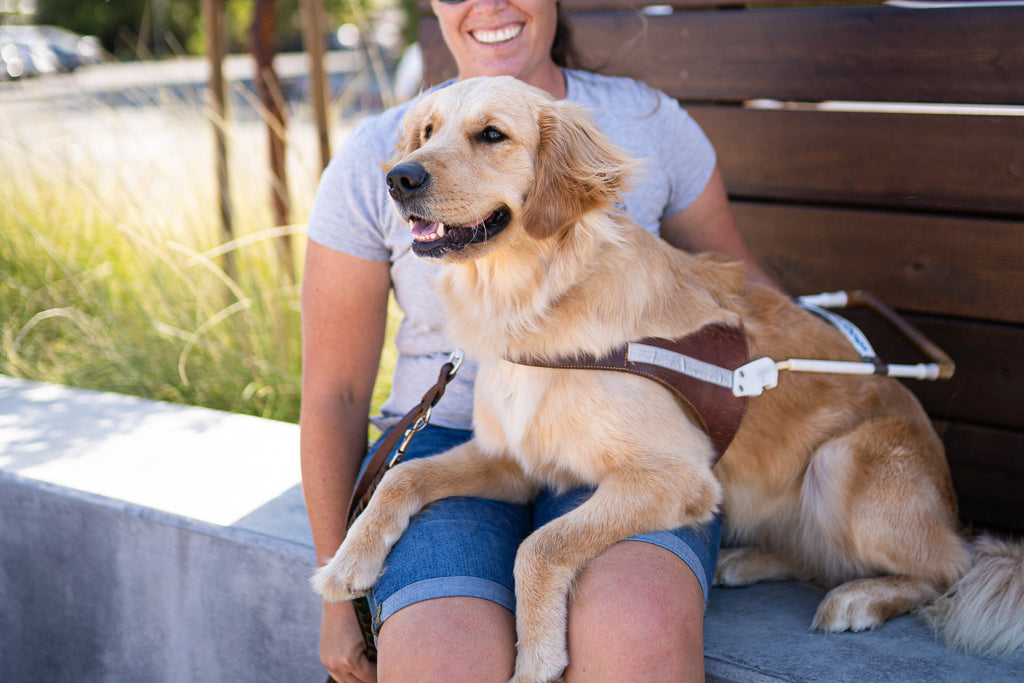Pip's Story
Pip the guide dog is a super puppy determined to help anyone she meets, overcoming any obstacle in her way. We're happy to welcome her to the growing family of My Guide Dogs! She will only be adoptable for a limited time!
Learn More About
Guide Dogs
Why are Guide Dogs so special?
Guide dogs mean so much to the blind community. They help the blind and visually impaired get around freely, see their loved ones more often, and experience life to the fullest. Plus, they’re smart, caring, loyal, and protective to a fault—they’re four-legged superheroes!
Can any dog become a guide dog?
Early on, German Shepherds were the most utilized breed for service positions, but today many breeds fill these spots including Golden Retrievers, Labradors, Labrador Retrievers, Poodles and Labradoodles. All of these breeds are used because they have the necessary intelligence, temperament and health qualities to be a successful dog guide.
Size is also important because the height of the dog at the shoulder, plus the length of the harness, must fit comfortably with the height of the handler. The most popular service dog breed today is the Labrador Retriever due to its size range, short hair coat, and mild temperament.
How do you train a guide dog?
Training a guide dog can take anywhere from 18 months to up to two years. In its first year, the guide dog will live with a puppy raiser who has volunteered to raise them, house train them and teach them obedience. Once ready, the dog will then participate in professional training for around four to six months. After around 18 months, the guide dog will then meet its intended owner and the pair will continue training together.
What skills do guide dogs learn?
Guide dogs are proficient in leading a human safely to a designated location. This entails watching for hazards from above and below - low hanging tree limbs or power lines, curbs, stairs, potholes, etc. In addition to heeding commands, guide dogs learn how to reason.
If the handler issues a command to cross a street as traffic approaches, the dog learns to disobey. This ability is called intelligent disobedience and is critical to the safety of both humans and dogs.
It’s important to keep in mind that while guide dogs are highly intelligent, they cannot read traffic signals or determine the route to a new destination. Ultimately, their handlers are always in control.
How expensive is it to train a guide dog?
One guide dog takes about two years to train and costs a total of $45,000 to $60,000, covering everything from boarding a dog to extensive drilling by professional trainers in serving the needs of the blind and visually impaired to a weeklong period acclimating the dog to the recipient. Guide dogs who make it through the program are provided free to people who need them.
How do people get paired with a guide dog?
Guide dogs are very carefully paired with their handlers. Everything from a person’s lifestyle, hobbies, activity level, family, living arrangements, and other pets go into the pairing process when a person applies for a guide dog through a nonprofit organization.
Can I pet them if I see one on the street?
While in their harnesses, guide dogs are working, and you should not pet them. Although they are friendly and adorable, resist your urge to pet guide dogs when you see them working in their harness.
When do guide dogs retire?
A guide dog's average working life is six to seven years and they normally retire at about 10 or 11 years old, depending on their health and the amount of work they need to do. A retired guide dog can stay with its owner, as long as they can be well taken care of, but a new home can also be nominated.

